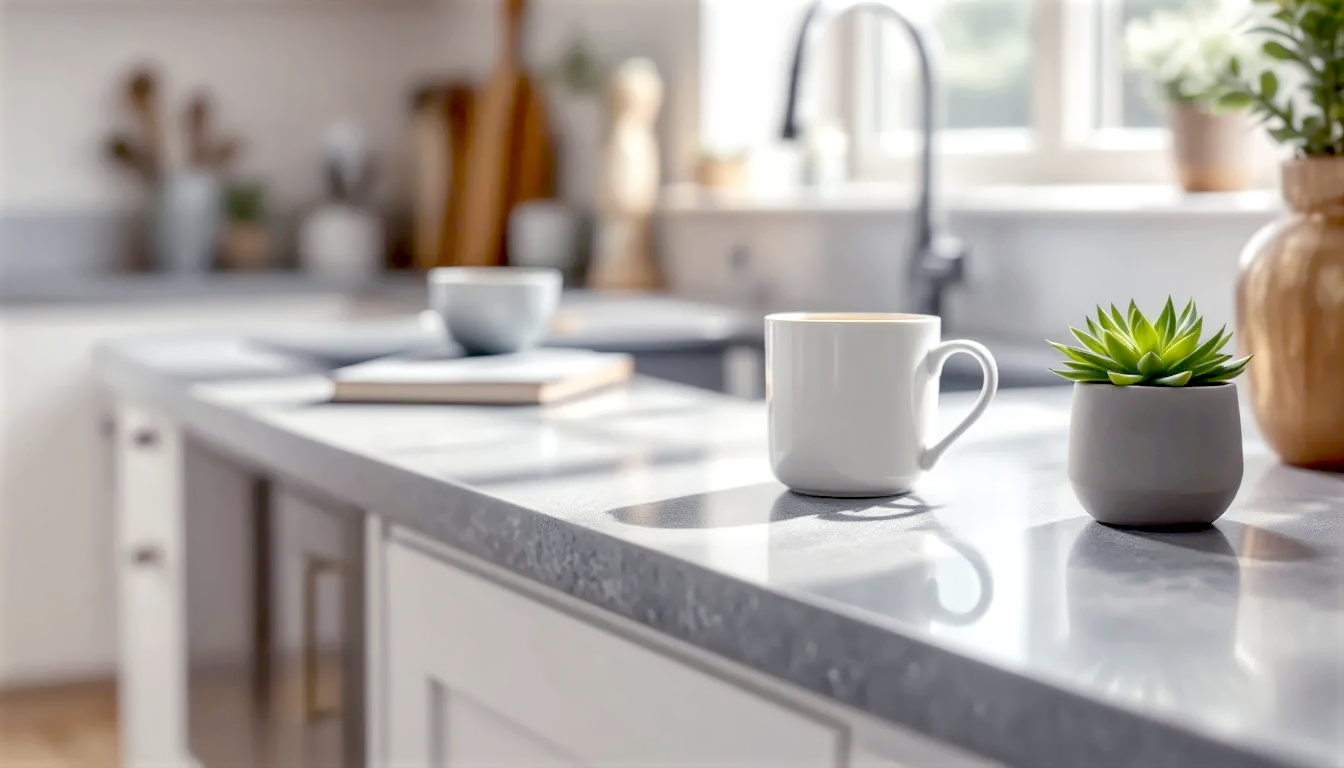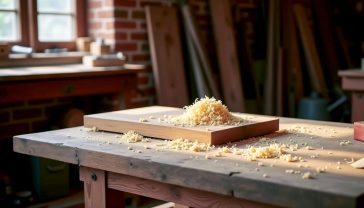Are Granite Worktops Expensive? The UK Guide to Costs, Value, and Making the Right Choice
Is granite worth it? This definitive guide explores UK granite worktop costs, hidden fees, factors affecting price, and how it compares to other materials.

This post may contain affiliate links. If you make a purchase through these links, we may earn a commission at no additional cost to you.
Picture this: you’re standing in your kitchen, mug of tea in hand, the morning light catching the surface of your worktop. It’s cool to the touch, solid, with a unique pattern of flecks and veins that you’ll never find in another home. For decades, granite has been the gold standard for kitchen worktops—a symbol of quality, durability, and timeless style.
But there’s always been a question mark hanging over it, one that often stops dream kitchen plans in their tracks: the cost.
So, are granite worktops expensive? The simple answer is yes, they often cost more upfront than materials like laminate. But the real answer is far more interesting. It’s not just about the initial price tag; it’s about value, longevity, and what you’re actually paying for. Think of it less like buying a simple kitchen surface and more like making a long-term investment in your home.
This guide will break it all down. We’ll get into the nitty-gritty of pricing, explore what makes one slab of stone cost more than another, compare it to the other options on the market, and ultimately help you decide if granite is the right—and affordable—choice for your British home. Let’s put the kettle on and get started.
What Actually Is Granite? A Quick Geology Lesson for the Kitchen
Before we talk money, it helps to know what we’re dealing with. Unlike quartz or laminate, which are engineered by humans, granite is 100% natural stone. It’s an igneous rock, which is a fancy way of saying it was born from cooled magma deep within the Earth’s crust over millions of years.
This fiery origin story is exactly what gives granite its superpowers in the kitchen:
- It’s incredibly hard. Made up of minerals like quartz and feldspar, granite is one of the toughest natural stones out there. It’s resistant to scratches and chips, meaning it can handle the daily chaos of a busy family kitchen. Dropped pans and stray knives are less of a worry.
- It’s heat-resistant. Because it was formed in extreme heat, you can place a hot pan directly onto a granite surface without causing scorch marks or damage. It’s a small convenience that makes a huge difference when you’re juggling pots and pans.
- Every single slab is unique. The mix of minerals, the pressure, the cooling process—it all combines to create a one-of-a-kind pattern and colour. The granite worktop in your kitchen will have its own distinct character, something that manufactured materials can only try to imitate.
This natural origin is the first clue to its cost. Granite isn’t churned out in a factory; it has to be found, quarried in massive blocks from mountainsides in places like Brazil, India, and Italy, sliced into slabs, and shipped across the world. That entire journey, from mountain to your kitchen, is baked into the final price.
The Big Question: So, How Much Do Granite Worktops Cost in the UK?
Alright, let’s get down to brass tacks. The price of granite worktops in the UK can vary wildly, but as a general rule of thumb, you can expect to pay somewhere between £180 and £600+ per square metre (m²), including professional installation.
That’s a massive range, isn’t it? To make it more manageable, suppliers usually group granite into different price bands or tiers.
- Entry-Level Granite (approx. £180 – £250 per m²): This tier typically includes common, widely available colours and patterns. Think consistent, speckled granites in shades of black, grey, and beige, like Absolute Black or Steel Grey. They are quarried in huge quantities, making them more affordable. They offer all the durability of granite without the premium price tag.
- Mid-Range Granite (approx. £250 – £400 per m²): Here you’ll find more variation in colour and pattern. The veining might be more striking, or the background colours might be less common. Slabs in this range, such as Black Pearl or Kashmir White, often come from smaller quarries or have more desirable aesthetics.
- High-End & Exotic Granite (approx. £400 – £600+ per m²): This is where things get really special. These granites are prized for their rarity, stunning beauty, and dramatic patterns. They might feature rare blue or deep red hues (like Blue Bahia or Juparana Colombo) or have incredible, flowing veins that look like a piece of art. They are quarried in very limited quantities, and their price reflects their exclusivity.
A Worked Example: Costing a Typical British Kitchen
Numbers on their own can be a bit abstract. Let’s see how this plays out in two common kitchen scenarios. (These are ballpark figures and include templating, fabrication, and installation.)
- Scenario 1: The Compact Galley Kitchen
- Worktop Area: 3 square metres
- Entry-Level Granite: 3m² x £220/m² = £660
- Mid-Range Granite: 3m² x £320/m² = £960
- High-End Granite: 3m² x £500/m² = £1,500
- Scenario 2: The Modern Family Kitchen with an Island
- Worktop Area: 6 square metres
- Entry-Level Granite: 6m² x £220/m² = £1,320
- Mid-Range Granite: 6m² x £320/m² = £1,920
- High-End Granite: 6m² x £500/m² = £3,000
As you can see, the choice of stone itself is the biggest lever you can pull to manage the budget. But it’s far from the only factor.
Unpacking the Price Tag: The 7 Key Factors That Determine Granite Cost
Why does one slab of rock cost three times as much as another? It comes down to a blend of geology, economics, and craftsmanship.
1. The Grade of the Granite: From Common to Couture
As we’ve seen, this is the number one driver. The rarity and perceived beauty of the stone dictate its base price. A common, uniform grey granite is simply easier and cheaper to source than a rare blue one with rivers of gold running through it.
2. The Rarity and Colour: Supply and Demand in Stone Form
Some colours and patterns are much harder to find. Blue, red, and purple granites are geological rarities, so their price is naturally higher. Similarly, slabs with clear, consistent patterns and minimal “inclusions” (blotches or imperfections) are often graded higher and cost more.
3. The Thickness of the Slab: 20mm vs. 30mm
In the UK, granite worktops typically come in two standard thicknesses: 20mm and 30mm.
- 30mm: This is the traditional, classic choice. It feels substantial, looks premium, and can support wider, unsupported overhangs (like on a breakfast bar). It uses 50% more raw material, so it’s naturally more expensive.
- 20mm: A more contemporary and budget-friendly option. It offers a sleeker, more minimalist look and is perfectly durable for most kitchen uses. However, it might require extra support for overhangs and some people feel it lacks the ‘heft’ of a 30mm worktop. Opting for 20mm can save you a good chunk of money.
4. The Finish: Polished, Honed, or Leathered?
How the surface of the granite is treated also affects the price.
- Polished: The most common and usually the least expensive finish. It’s buffed to a high shine, which reflects light beautifully and makes the colours pop. It’s also the least porous finish, offering the best stain resistance.
- Honed (Matte): The slab is sanded to a smooth, matte finish. It looks soft and contemporary but can be more susceptible to showing fingerprints and requires more diligent sealing to prevent stains. The extra processing often adds a small premium to the cost.
- Leathered (Textured): This finish adds a subtle, soft texture to the surface, a bit like brushed leather. It’s fantastic for hiding smudges and adds a unique tactile quality. It’s the most complex finish to create and therefore usually the most expensive option.
5. The Complexity of the Job: Cutouts, Curves, and Edge Profiles
A simple, straight run of worktop is far cheaper to produce than one with lots of complex cuts. Every extra feature adds to the fabrication time and cost.
- Cutouts: Each hole needed for a sink (undermount sinks cost more than top-mount), hob, or pop-up socket requires precise cutting and finishing.
- Drainage Grooves: Grooves cut into the stone next to the sink for drainage are a popular but costly extra.
- Edge Profiles: A standard, slightly bevelled edge is usually included in the base price. But if you want a more decorative edge like an Ogee, Bullnose, or Dupont, you’ll pay extra for the specialist tooling and labour.
- Curves and unusual shapes: These are much harder to cut than straight lines and will significantly increase the fabrication cost.
6. The Source: Where in the World Did Your Worktop Come From?
Granite is heavy. Transporting it from a quarry in Brazil to a stonemason in Britain costs a lot in fuel and logistics. Stones from European quarries (like those in Italy or Norway) may have lower transport costs than those from further afield, which can sometimes be reflected in the price.
7. The Supplier and Installer: The ‘Postcode Lottery’ of Kitchen Fitting
Finally, the company you choose will have a big impact. A large national chain might have great buying power but higher overheads. A small, local, family-run stonemason might offer a more personal service and competitive pricing. It always, always pays to get at least three detailed, itemised quotes from different suppliers.
Beyond the Stone: The Hidden Costs You Can’t Ignore
The price per square metre is just the start. When budgeting for granite, you need to account for the other essential services and potential extras that can add up.
- Templating: This is a crucial step where a professional visits your home to create an exact template (often using wood or digital laser equipment) of your kitchen cabinets. This ensures the final granite is cut to a perfect fit. This service is almost always included in a reputable quote.
- Fabrication: The cost of cutting, shaping, and finishing the stone to your template. Again, this should be part of the main quote.
- Installation: The labour cost for the skilled team who will deliver and fit the heavy slabs. Don’t underestimate this—it’s a tough job that requires expertise.
- Sink & Hob Cutouts: As mentioned, these are usually priced per item.
- Plumbing and Electricals: Your worktop fitters are stonemasons, not plumbers or electricians. You will need to hire separate tradespeople to disconnect your old sink and hob and reconnect the new ones.
- Removal of Old Worktops: Some companies include this, others charge extra. Be sure to ask.
- Additional Supports: If you have a large overhang for a breakfast bar or are using a thinner 20mm slab, you might need to pay for steel support bars to be routed into the underside of the stone.
A trustworthy quote should be fully itemised, so you can see exactly where your money is going. If a price seems too good to be true, it probably is—they might be skipping steps or using lower-quality stone.
Granite vs. The Contenders: A Cost and Value Showdown
So, how does granite stack up against the other popular worktop materials in the UK? The initial cost is one thing, but performance and longevity are just as important.
| Material | Typical Price (per m², installed) | Pros | Cons | Best For |
|---|---|---|---|---|
| Laminate | £40 – £100 | Extremely affordable, huge range of designs, easy DIY installation. | Prone to scratching, burns, and water damage at the seams. Short lifespan. | Budget renovations, rental properties, and those who like to change styles often. |
| Solid Wood | £120 – £300 | Warm, natural aesthetic, can be sanded and repaired. | Requires regular oiling, can scorch, scratch, and stain easily. | Traditional, rustic, or country-style kitchens. |
| Granite | £180 – £600+ | Extremely durable, heat and scratch-resistant, each piece is unique, timeless appeal. | Porous (needs sealing), can be expensive, limited colour palette compared to quartz. | Busy family kitchens, a long-term investment, adding property value. |
| Quartz | £250 – £700 | Non-porous (no sealing), very durable, consistent patterns, vast colour range. | Not as heat-resistant as granite, can look a bit uniform, high-end brands are pricey. | Modern and minimalist kitchens, those wanting a specific colour or low maintenance. |
| Marble | £300 – £800 | Unmatched luxury aesthetic, beautiful veining, stays cool to the touch. | Very soft and porous, scratches and stains very easily, high maintenance. | Luxury kitchens with careful owners, keen bakers, or as a statement island. |
| Sintered Stone | £350 – £900 | Almost indestructible: heat, scratch, UV, and stain-proof. Very slim profiles possible. | Very expensive, can be brittle on impact, complex installation. | High-end modern kitchens, indoor/outdoor use, ultimate performance seekers. |
This comparison highlights granite’s sweet spot. It offers a huge step up in durability and luxury from laminate and wood, but often at a more accessible price point than high-end quartz, marble, or sintered stone. It’s the perfect middle-ground for someone who wants natural beauty and performance that will last a lifetime.
Is Granite a Good Investment? Looking at Long-Term Value
A kitchen renovation is one of the biggest investments you’ll make in your home. So, does granite pay off in the long run?
- Durability and Lifespan: A well-maintained granite worktop can genuinely last a lifetime. Laminate might need replacing every 10-15 years, and wood can start to look tired without constant care. Granite, however, will look just as good in 20 years as it does on the day it’s installed. When you divide the initial cost over its potential lifespan, the annual cost becomes very reasonable.
- Impact on Property Value: For years, estate agents have agreed that a high-quality kitchen sells a house. Granite worktops are a key feature that signals a well-finished, premium home to potential buyers. While you might not recoup 100% of the cost, it undoubtedly makes your property more attractive and can help it sell faster and for a better price. It adds a ‘wow’ factor that laminate just can’t match.
- Maintenance Costs: Granite isn’t entirely maintenance-free. Because it’s a natural stone, it’s porous, meaning it can absorb liquids. To prevent staining, it needs to be sealed. A good installer will apply the first coat of sealant, which should last for at least a year. After that, you’ll need to re-seal it every 1-3 years. You can do this yourself with a simple spray-on sealant from a hardware shop for around £20. It’s a quick job, and it’s a very small ongoing cost to protect a significant investment.
How to Save Money on Granite Worktops Without Cutting Corners
If you’ve got your heart set on granite but the budget is tight, don’t despair. There are several clever ways to get the look for less.
- Choose a Common Colour: Opt for an entry-level granite. A popular Steel Grey or Absolute Black still offers incredible durability and a premium feel at a fraction of the cost of an exotic slab.
- Go for 20mm Thickness: Unless you need a very large, unsupported overhang, a 20mm slab will look fantastic and save you money.
- Keep the Design Simple: Avoid complex curves and fancy edge profiles. Stick to straight lines and standard edges to keep fabrication costs down.
- Use Offcuts for Smaller Jobs: If you only need a small piece for a utility room, vanity unit, or chopping board, ask suppliers if they have any ‘offcuts’ from larger jobs. You can get a beautiful piece of high-end stone for a bargain price.
- Get Multiple, Itemised Quotes: We can’t stress this enough. Prices can vary significantly between suppliers. Get detailed quotes that list every single cost, so you can compare them like for like.
- Work with a Local Stonemason: Independent, local workshops often have lower overheads than big showrooms and can offer fantastic value and craftsmanship.
The Verdict: Are Granite Worktops Really Expensive?
Let’s go back to our original question. Yes, the upfront cost of granite is higher than some other materials. You are paying for a unique piece of geological history, expert craftsmanship, and a complex logistical journey.
But to call it ‘expensive’ is to miss the point. Granite is about value, not cost.
It’s the value of a surface that won’t scratch when your teenager decides to make toast directly on it. It’s the value of a worktop that won’t burn when you forget a trivet. It’s the value of a beautiful, timeless feature that will elevate your home and won’t need replacing for decades, if ever.
When you factor in its incredible lifespan and the positive impact on your home’s value, granite starts to look less like an expense and more like one of the smartest investments you can make in your kitchen. It’s a piece of the planet, polished for your home—and that’s something worth paying for.
Further Reading
For more inspiration and technical information, you can explore these highly-respected resources:
- The Stone Federation of Great Britain: The official trade association for the natural stone industry, offering reliable technical advice.
- Houzz UK: A fantastic platform for kitchen design inspiration and for finding local, reviewed professionals.
- Ideal Home Magazine: A trusted source for UK home renovation trends, advice, and cost guides.
- Marble & Granite Designs: UK granite fabricators with a wealth of content on their blog to help you choose wisely.






